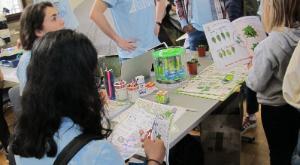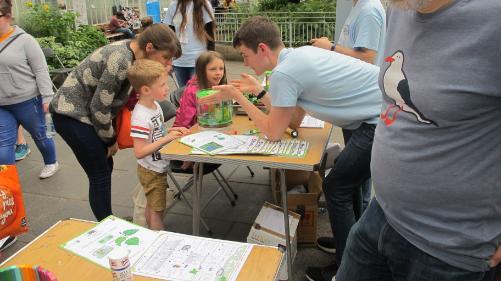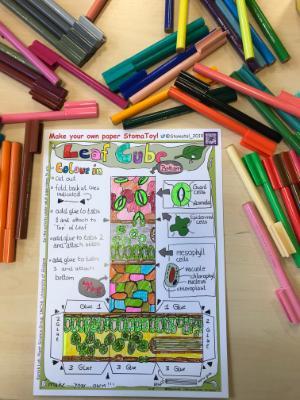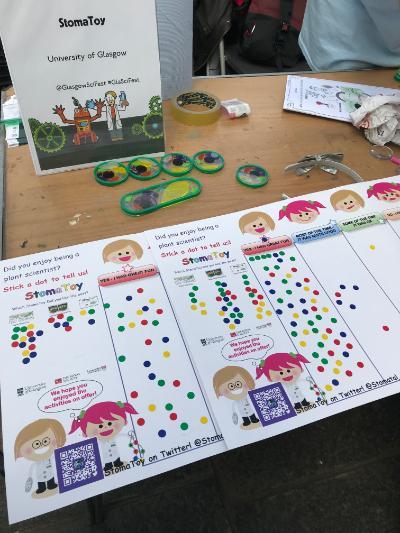StomaToy statement
 The StomaToy project has developed a set of activities that combine plant science, music and drawings to communicate concepts of plant stomatal biology through play. The project is led by Dr Rucha Karnik’s lab within the Plant Science Group, Institute of Molecular, Cell and Systems Biology, at the University of Glasgow. The StomaToys include:
The StomaToy project has developed a set of activities that combine plant science, music and drawings to communicate concepts of plant stomatal biology through play. The project is led by Dr Rucha Karnik’s lab within the Plant Science Group, Institute of Molecular, Cell and Systems Biology, at the University of Glasgow. The StomaToys include:
- Interactive StomaToy
- Activity book
- Make your own StomaToy
- Video
These comprehensive educational resources were generated in cross-disciplinary collaborations. Indeed, plants are an indispensable part of human lives and plant science, at the forefront of biological research, endeavors to resolve future global food security through gain of fundamental knowledge. Hence, demonstrating the importance of plant science research to everyday life is a vital element of our research. To give children a taste of being a plant scientist, the StomaToy Activity book includes a pathogen infection experiment with images of infected/healthy Arabidopsis plants and educates about plant biology and disease as well as stomata as the guardians of the plants through color-in activities. The paper StomaToy Cube combines color-in, cutting out and assembly of your own leaf cross-section providing opportunity for younger children to learn about plants, leaf organisation and stomata. In the StomaToy booklet and the leaf cube, plant science is conveyed through drawings by Dr Mathis Riehle, a Cell Engineer in the Institute. For the StomaToy project Mathis has interpreted and represented plant science as drawings that are attractive to children and adults alike. The StomaToy video shows how plants and stomatal pores on leaves are important to us. The video is aimed at all age groups and has been prepared and edited by a member of the public, Flora Leask, who has worked on this together with Lingfeng Xia, a plant scientist PhD student in the Karnik Lab.
To give children a taste of being a plant scientist, the StomaToy Activity book includes a pathogen infection experiment with images of infected/healthy Arabidopsis plants and educates about plant biology and disease as well as stomata as the guardians of the plants through color-in activities. The paper StomaToy Cube combines color-in, cutting out and assembly of your own leaf cross-section providing opportunity for younger children to learn about plants, leaf organisation and stomata. In the StomaToy booklet and the leaf cube, plant science is conveyed through drawings by Dr Mathis Riehle, a Cell Engineer in the Institute. For the StomaToy project Mathis has interpreted and represented plant science as drawings that are attractive to children and adults alike. The StomaToy video shows how plants and stomatal pores on leaves are important to us. The video is aimed at all age groups and has been prepared and edited by a member of the public, Flora Leask, who has worked on this together with Lingfeng Xia, a plant scientist PhD student in the Karnik Lab.
 Often, we do not see plant science as relevant to modern life. Yet, there are many parallels that can be drawn between plants and humans, for example, like humans, plants also have a complex immune system for pathogen defense. When we put dirty hands into our mouth, it can cause infection. Similarly, the entry of pathogen through stomatal pores on leaves enables infection in plants! To this end, the interactive StomaToy represents a leaf section and conveys the concepts of light-activated stomatal opening, pathogen entry and cellular immune signaling using interactive light displays. It was conceptualized and built in collaboration with the Dr Abe Karnik’s Human Computer Interaction (HCI) lab, Interactive Systems Group at Lancaster University.
Often, we do not see plant science as relevant to modern life. Yet, there are many parallels that can be drawn between plants and humans, for example, like humans, plants also have a complex immune system for pathogen defense. When we put dirty hands into our mouth, it can cause infection. Similarly, the entry of pathogen through stomatal pores on leaves enables infection in plants! To this end, the interactive StomaToy represents a leaf section and conveys the concepts of light-activated stomatal opening, pathogen entry and cellular immune signaling using interactive light displays. It was conceptualized and built in collaboration with the Dr Abe Karnik’s Human Computer Interaction (HCI) lab, Interactive Systems Group at Lancaster University.
Research shows that young children have made their minds up about science/careers by age 9-10. Therefore, to infect future plant science with enthusiasm for research it is important to inspire children early on in life and to bring scientific awareness to members of the public who care for the children. Through the StomaToy activities we aim to engage young children and non-plant scientist members of the public with the fascinating world of plant defense and plant science research and to inspire people to explore and understand the importance of plant science in our day-to-day lives.

The StomaToy project is supported by funding from the Royal Society and the MVLS Engagement Fund. Plant Science research in Karnik lab is funded by the Royal Society, University of Glasgow and the BBSRC.
You can meet the StomaToy team by visiting StomaToy Outreach or follow the StomaToy journey on Twitter @Stomatal_2019.
If you would like to use StomaToy resources for education please email: Rucha.karnik@glasgow.ac.uk.

